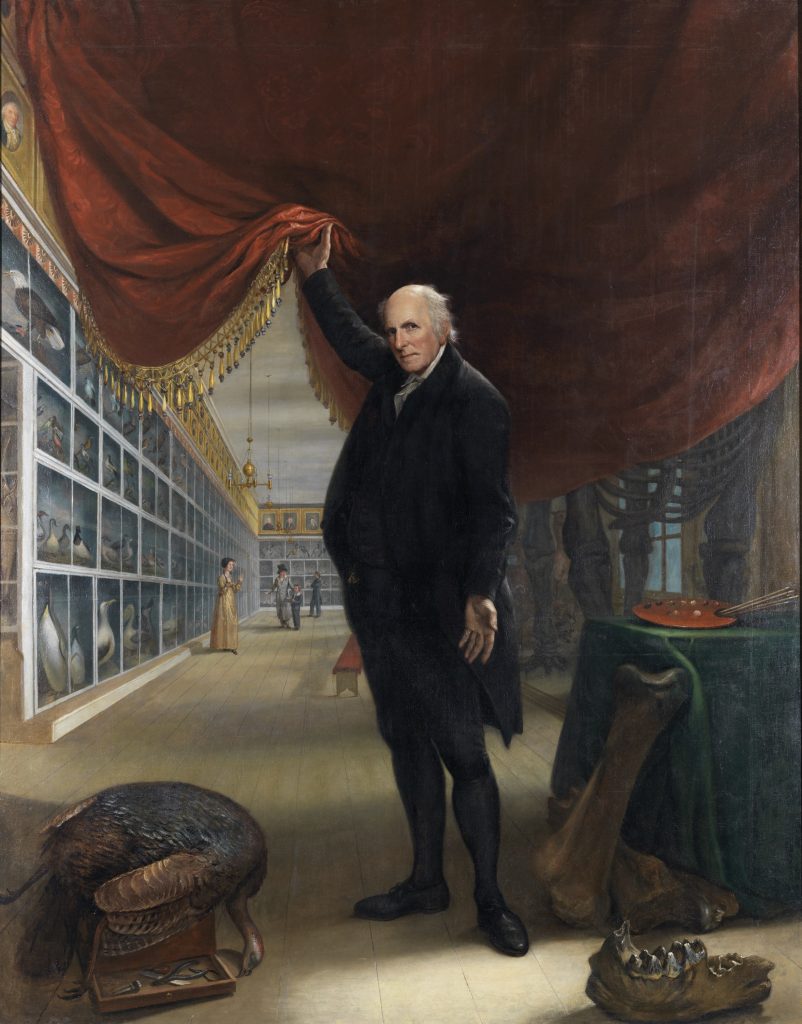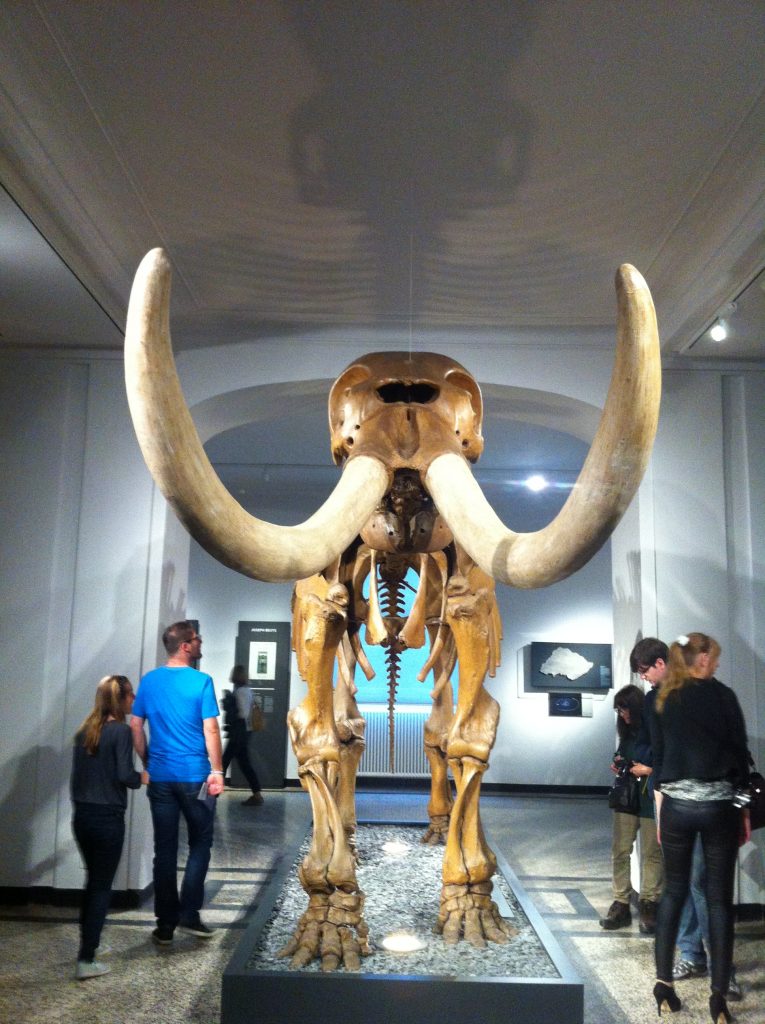Nature: A Nineteenth-Century Engraving Linking Charles Willson Peale, James Akin, and Peale’s Mastodon
In September 2014, the Hessisches Landesmuseum in Darmstadt, Germany, reopened after a seven-year closure for renovations. I had moved to Darmstadt the previous year, and my daily commute took me past the darkened natural history and art museum. Soon after it reopened, I was able to visit the museum and was surprised to find Charles Willson Peale’s mastodon skeleton—immortalized behind drapery in the 1822 self-portrait, The Artist in His Museum (fig. 1)—mounted on display in the permanent galleries. Excited, I took photos on my iPhone (fig. 2) to share with American art history colleagues in the United States. “Did you know Peale’s mastodon is in Germany?!,” I asked in emails and in a post on social media. No one seemed to have known, with responses generally disbelieving.
Peale’s mastodon has been the subject of significant recent media coverage because it has returned to the United States for the first time in more than 150 years to be displayed in the Smithsonian American Art Museum’s exhibition Alexander von Humboldt and the United States: Art, Nature and Culture.1 However, in 2014 scarce information on the mastodon was available online. Initial searches led me to the 1954 article “The Rediscovery of Peale’s Mastodon,” published in the Proceedings of the American Philosophical Society by George Gaylord Simpson of the American Museum of Natural History in New York and Heinz Tobien of the Hessisches Landesmuseum.2 Some sixty years prior to my walking through the newly renovated Landesmuseum and standing incredulous at the sight of the mastodon, Simpson and Tobien provided a brief sketch of the skeleton’s history. Still skeptical as to the fossil’s identity, I emailed the Head of the Natural History Department at the Landesmuseum, Dr. Gabrielle Gruber, who put me in touch with Dr. Oliver Sandrock, the current curator responsible for the mastodon. Dr. Sandrock was able to confirm that it was indeed the very same mastodon that Peale had showcased in his Philadelphia museum in the early 1800s.3
This felt a lot like serendipity. I had moved to Germany, where there is little historical American art in museum collections, and had encountered the skeleton of the Peale mastodon in my local museum. This was the impetus I needed to return to a frustrating puzzle piece in my research: a nineteenth-century engraving found on letterhead and gift solicitations for Peale’s Museum (figs. 3 and 4). The earliest example of the engraving appears on a letter, dated January 12, 1802, from Charles Willson Peale to Thomas Jefferson, the third president of the United States. Positioned at the top center of the paper, the engraving contains a standing putto pulling back drapery, inscribed with the word “NATURE” and tied to a tree branch, to reveal a landscape scene depicting birds and animals among hills and trees, and under the vignette, a quotation: “Of grains are Mountains form’d” (see fig. 3).4 In the middle of the scene is the likeness of a mastodon. Peale’s views on his museum comprise the main content of this three-page letter, with the first line stating, “The laborious, tho’ pleasing task of mounting the mammoth skeleton being done, gives me leisure to attend to other Interests of the museum.”5 In late 1801 and early 1802, Peale was consumed with the discovery of the mastodon and its placement within his museum, so it is not surprising that the fossil’s likeness would be found on documents from that period.
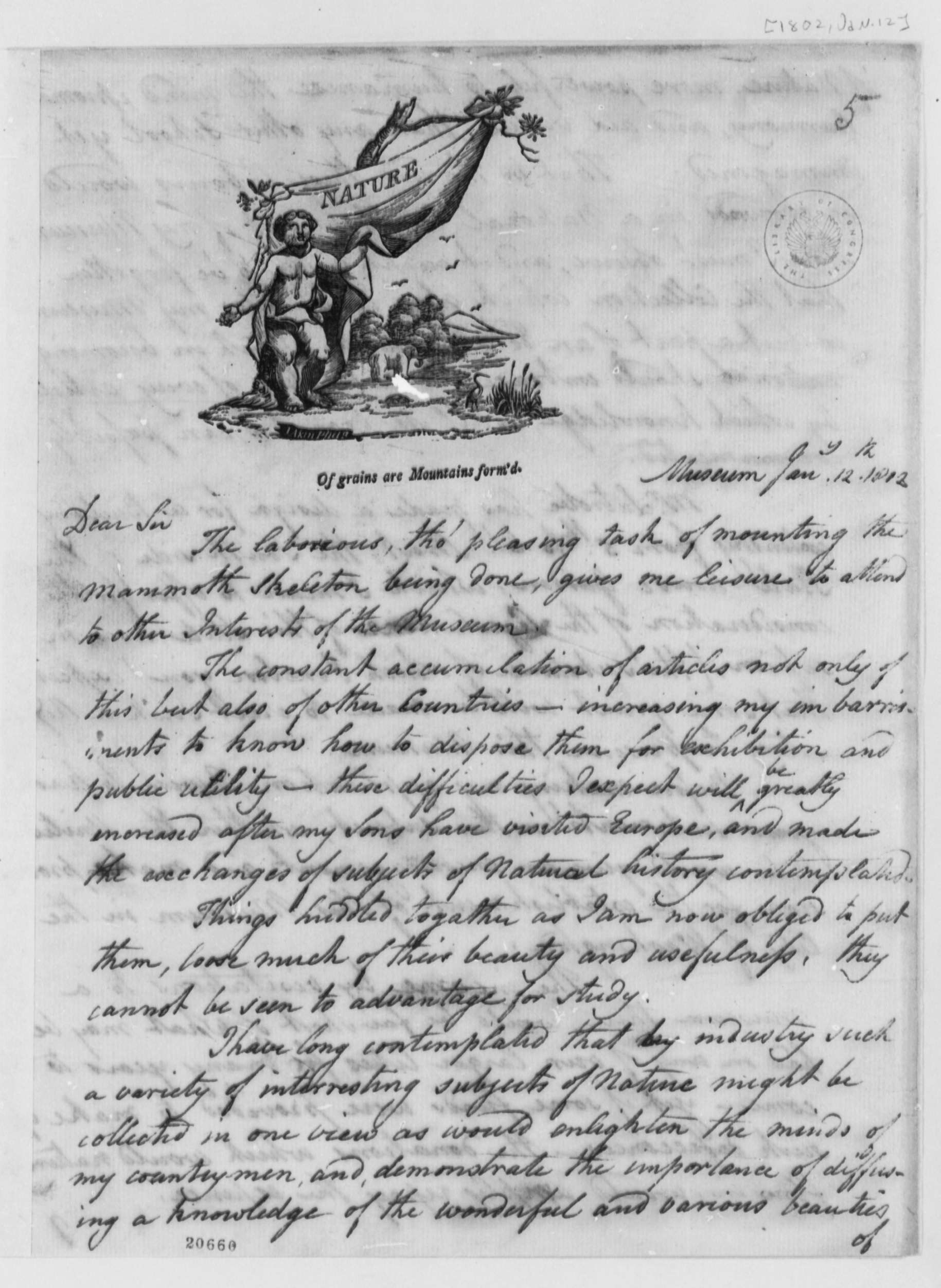
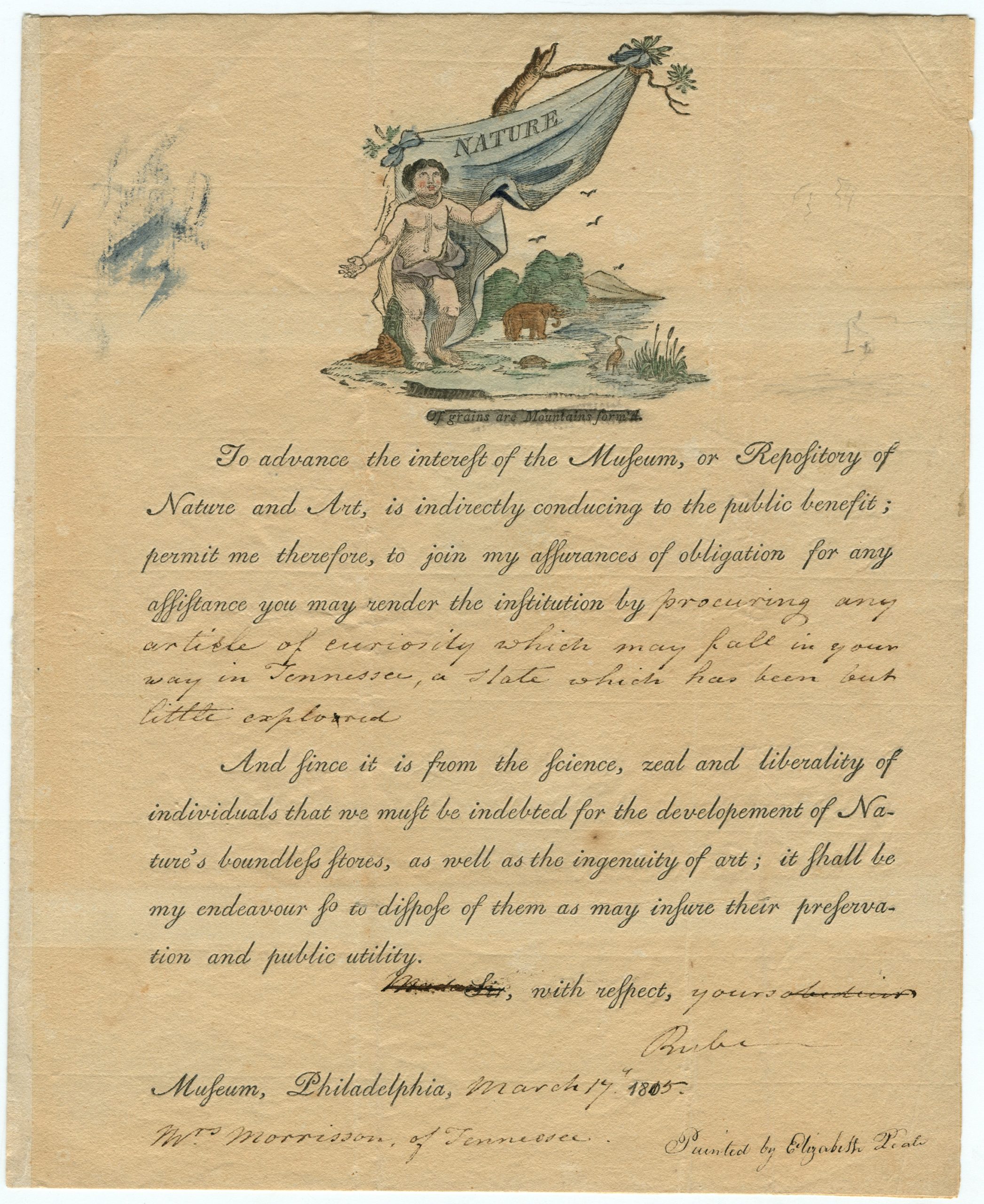
What immediately piqued my curiosity was not the subject matter but the prominent inclusion of the name “J. Akin, Phila.” directly under the putto’s feet. The signature refers to James Akin (1773–1846), one of the first artists in the United States to design and publish caricature prints. Akin is an important subject in my research on eighteenth- and nineteenth-century caricature in the United States, and the existence of this engraving adds complexity to Akin’s complicated life and career.6 The primary question that concerned me was why Akin would have been allowed to include his name on an image about which Peale must have felt strongly, an image that would be featured on gift solicitations for his museum and on letterhead sent to prominent political figures such as the President of the United States. I was also curious as to the scope of Akin’s relationship with Peale and if perhaps it was Akin who was responsible for both the design and printing of the engraving.
In scholarship on Peale that reproduces the Nature engraving, Akin’s name is often omitted. Any role he played in its conception and execution has been erased, with credit usually reserved for Peale alone. For example, in his book Mr. Peale’s Museum, Charles Coleman Sellers wrote in the caption, “In conjunction with expansion of the Museum into the State House in 1802, Peale designed this formal gift acknowledgment.”7 Sellers neither provides evidence for this assertion nor mentions Akin, despite the fact that the latter’s name is identifiable in the engraving and in the reproduction included in Sellers’s book. Sellers and other scholars likely assumed that Peale was responsible for the 1802 engraving because of an entry in his diary from July 20, 1788, in which the artist noted that on that day he had “struck off” a number of admission tickets.8 In the late 1780s, Peale attempted to work in mezzotint, engraving, and etching but soon abandoned printmaking when it proved financially unsuccessful.9 It is unclear whether Peale owned a press in 1802. A letter to his sons in England dated August 1802 indicates that he had plans to buy a printing press—which seems to suggest that in January of that year, when Nature was printed, he did not own one.10
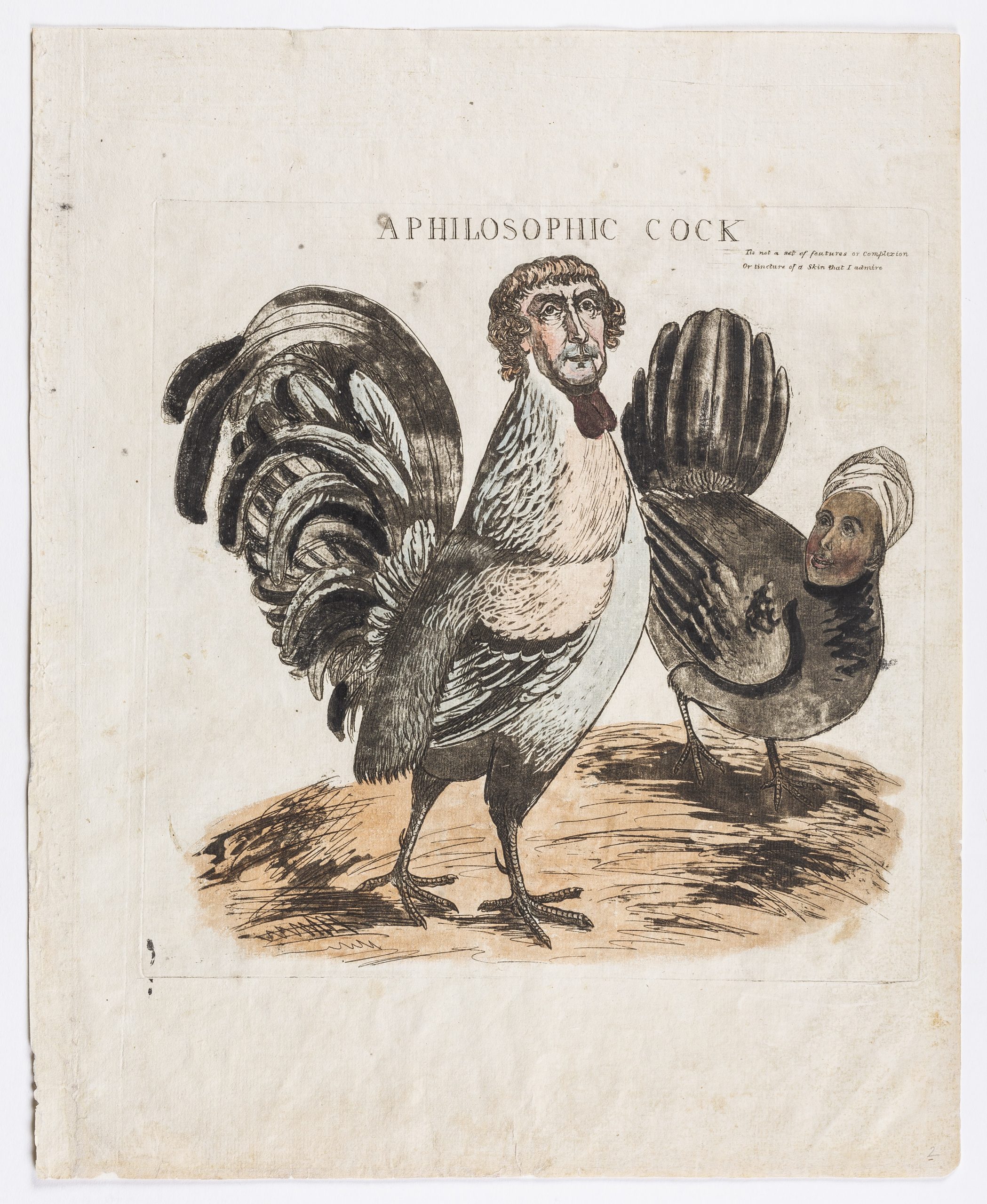
James Akin is a fascinating character, an engraver known today for having designed one of the most popular caricature prints of the early nineteenth-century—A Philosophic Cock (fig. 5), the only contemporary visual representation of Thomas Jefferson with Sally Hemings.11 Akin was born in South Carolina; however, his career was based in Philadelphia, with brief periods of activity in London and Newburyport, Massachusetts. A keen self-promoter, in letters and newspaper notices he alluded to associations with well-known artists. By delving into archival collections, I found that some of these allusions were in fact truthful, including Akin’s professional relationship to Peale and two of his sons, Rembrandt and Raphaelle.
Akin first referenced his connection to Peale and members of his family in 1797. That year, Akin placed newspaper advertisements in major cities along the East Coast announcing his plan to engrave prints after patriotic paintings depicting Revolutionary War battles.12 One of the paintings Akin sought to engrave was The Battle of Eutaw Springs, by the British artist Thomas Stothard. This painting is now lost; at the time of the advertisement, however, it was owned by Akin and could be seen at Peale’s Museum. Akin also provided the names of seven individuals accepting subscriptions for this project on his behalf. Listed first was Peale (“at his museum”), followed by his two sons Rembrandt and Raphaelle Peale (“at the Museum, Baltimore”). Akin’s proposal was ambitious for someone who had not as of yet—to my knowledge—produced a significant body of work in engraving, drawing, or painting.13 The Nature engraving further attests to the connection between Akin and Peale that began in 1797 and continued in 1802.
In my effort to uncover information on the relationship between Akin and Peale, other important questions, which thus far remain largely unanswered, came to the fore. Among them is whether Akin was solely responsible for the design and printing of the engraving. Akin’s conspicuous positioning of his name would seem to imply that he was claiming ownership of the design, but to what extent could this be proven outside of the signature? I tried to locate other evidence that differentiated divisions of labor between artists and engravers in the early nineteenth century, information found in letters or diaries, but found that surviving documents were rare. I also attempted to locate specific connections between Akin and Peale, hoping to find correspondence between the two men or a notation in a diary. When no such letters or references were found, I turned to legal documents. In my research on political caricature prints, I have often uncovered useful information by examining legal records, specifically court cases.
Although I have not encountered references to any legal dispute between Akin and Peale, I did learn that during the first decade of the 1800s Akin was embroiled in a number of lawsuits. One such suit, brought by a former Akin apprentice, provides important yet hitherto-unknown information regarding engraving practices in early nineteenth-century Philadelphia. Evidence in this case included an invoice and written testimonials less than a year after Akin printed the engraving for Peale.14 The conclusions to be drawn from these documents are twofold. First, by this point Akin had achieved relative success as an engraver in Philadelphia and was receiving enough engraving work to hire an apprentice. Second, Akin had been commissioned to work on various types of engraving projects, from labels for medication vials to fine-arts prints, including engraving specific elements on copperplates for other artists. In completed engravings that survive today, Akin’s name is not found, but the invoice attests that Akin and his apprentice played an integral role in realizing large-scale fine-arts engravings. This one example illuminates how various individuals contributed to engravings from this period.15
Even in the absence of legal disputes or surviving correspondence between the two men, Akin and Peale were clearly linked: the 1797 advertisement by Akin makes reference to their association, and the Akin engraving that Peale used in 1802 cements the fact that these two men knew one another and worked together professionally. For Peale to have allowed Akin to sign this engraving with his name in such a prominent location, with the knowledge that the image would be used on important museum documents, means that the two men had a collegial relationship in late 1801 and early 1802. At the very least, if Akin took the liberty of including his name without permission, Peale did not immediately correct it; instead, Peale featured the engraving on at least two letters to Jefferson and on gift solicitations from 1802.
The engraving was not used again until 1815, when Peale’s son Rubens resurrected it for a solicitation letter (see fig. 4). At least one formal gift certificate has survived, in the collection of the American Philosophical Society. Signed by Rubens Peale, who was at that time acting as director of the Peale Museum, the engraving was colored in by Rubens’s thirteen-year-old sister, Elizabeth Peale, with hand wash, or “painted,” as revealed by a handwritten note on the lower right-hand corner of the paper. Akin’s name has been covered over in black ink, along with the line under the engraving, “Of grains are Mountains form’d.”16 The erasure of Akin’s name may have resulted from a dispute between the Peale family and Akin, or perhaps the Peale family simply wanted to distance themselves from Akin and his reputation as a caricaturist.
The break between Akin and the Peale family likely occurred well before Rubens Peale used the engraving in 1815. It is possible that Akin’s politics in the early 1800s, combined with his focus on designing and publishing caricature prints, ended his association with Peale. Numerous documents for Akin survive from later in his life, including in 1828 when he unsuccessfully sought to become the Superintendent of the Patent Office in Washington, DC. Letters and other records consistently refer to Akin’s early career, with one document stating that Akin was an “eminent artist” who suffered for his “republicanism.”17 Akin’s caricature prints likely added to these purported setbacks. By way of example, the Massachusetts politician Timothy Pickering urged Akin to continue to produce “elegant specimens” of engraving and offered the valuable insight that potential clients were “afraid” that “they themselves [would] become subject of [Akin’s] tongue, [Akin’s] pencil, or [Akin’s] pen. And I think you consider your forte to lie in satirical drawings.”18 Pickering was responding to caricatures already published by Akin; indeed, Akin’s satirical attacks on the third president (see fig. 5) might have hastened the end of the Akin-Peale relationship.
Visiting the Darmstadt Landesmuseum and seeing the Peale Mastodon reenergized my interest in the relationship between Akin and Peale and how the Nature engraving connects them. The theories I have been pursuing as to why Peale might have allowed Akin to so prominently display his name in an 1802 engraving are largely circumstantial. Nonetheless, the Nature engraving is a striking example of divisions of labor and of the tightly interwoven connections between artists and engravers in the early nineteenth century. Given the many steps and individuals needed to create a single engraving—from the copperplates produced to the tools used, to the work completed or started by apprentices, to the specialists skilled in engraving specific parts of a plate—it is impossible to make firm attributions. The questions as to why Peale would entrust the design and printing of such an important image to Akin and why he would allow Akin to so prominently display his name cannot yet be definitively answered. Further—and perhaps of greater consequence—is the notion that if Akin did design the engraving, he may have gone on to influence Peale’s later works as well. This question is especially intriguing because the motif of the putto pulling back drapery to reveal what was behind it is thought to have inspired Peale’s 1822 self-portrait, The Artist in His Museum.19 No doubt, there remains more we can learn from this nineteenth-century engraving.
Cite this article: Allison M. Stagg, “Nature: A Nineteenth-Century Engraving Linking Charles Willson Peale, James Akin, and Peale’s Mastodon,” Panorama: Journal of the Association of Historians of American Art 7, no. 1 (Spring 2021), https://doi.org/10.24926/24716839.11722.
PDF: Stagg, Nature
Notes
- Due to restrictions related to COVID-19, the Smithsonian American Art Museum was closed for most of 2020 and 2021. At the time of writing, the museum has reopened and the exhibition has been extended until July 2021. Curator Eleanor J. Harvey produced a magnificent catalogue for the exhibition, Alexander von Humboldt and the United States: Art, Nature, and Culture (Washington, DC: Smithsonian American Art Museum and Princeton University Press, 2019), and various online resources are also available, including virtual tours of the show and a video of the mastodon’s journey from Darmstadt to Washington, DC; https://americanart.si.edu/exhibitions/humboldt. ↵
- George Gaylord Simpson and Heinz Tobien, “The Rediscovery of Peale’s Mastodon,” Proceedings of the American Philosophical Society 98 (1954): 279–81. ↵
- Dr. Allison Stagg to Dr. Gabrielle Gruber, September 15, 2014; Dr. Oliver Sandrock to Dr. Allison Stagg, September 16, 2014. ↵
- Charles Willson Peale to Thomas Jefferson, January 12, 1802. The Thomas Jefferson Papers at the Library of Congress, Manuscript Division. ↵
- In the nineteenth century, the mastodon skeleton was referred to as a “mammoth.” However, it was later discovered that the “mammoth” bones were really those of a mastodon. For clarity and consistency, I refer to Peale’s skeleton as a “mastodon.” ↵
- Allison M. Stagg, “The Art of Wit: Political Caricature in the United States, 1789–1832” (PhD diss., University College London, 2011); and Allison M. Stagg, “All in my eye!” James Akin and His Newburyport Social Caricatures,” Commonplace: The Journal of Early American life 10, no. 2 (January 2010), http://commonplace.online/article/all-in-my-eye-james-akin. The author has written a monograph on American political caricature, “Prints of a new kind”: Political Caricature in the United States, 1790–1828 (forthcoming from Pennsylvania State University Press). ↵
- Charles Coleman Sellers, Mr. Peale’s Museum: Charles Willson Peale and the First Popular Museum of Natural Science and Art (New York: Norton, 1980), 155. ↵
- Sellers, Mr. Peale’s Museum, 36–37; a surviving example of the 1788 admission ticket can be found on page 37. ↵
- E. P. Richardson, “Charles Willson Peale’s ‘Engravings in the Year of National Crises, 1787,’” Winterthur Portfolio 1 (1964): 166–81; for a brief overview of Peale’s printmaking activity, see especially Carol Eaton Soltis, The Art of the Peales in the Philadelphia Museum of Art: Adaptions and Innovations (New Haven, CT, and London: Yale University Press, 2017), 133–37. ↵
- Charles Willson Peale to Rubens and Rembrandt Peale, August 20, 1802; quoted in Sellers, Mr. Peale’s Museum, 154. ↵
- The author is indebted to Maureen O’Brien Quimby’s doctoral and postdoctoral research on James Akin. See Maureen O’Brien Quimby, “The Political Art of James Akin,” Winterthur Portfolio 7 (1972): 59–112; for information on the relationship between Jefferson and Hemings, see Annette Gordon-Reed, The Hemingses of Monticello: An American Family (New York and London: W. W. Norton & Company, 2008) Chapter 26, 540–61. ↵
- This advertisement can be found in newspapers along the East Coast between June and September 1797. In the advertisement, Akin announces that he, “having employed a considerable part of my life in acquiring a knowledge of the fine arts, from the most celebrated and esteemed masters in Europe . . .” Despite this claim, no examples of engravings by Akin from this period have been located. ↵
- It is unlikely that this venture was successful, as there are no extant engravings from the proposed subscription. ↵
- William Kneass v. James Akin, 1807. McAllister Papers, Library Company of Philadelphia. ↵
- Another major resource not cited in the body of this Research Note is the Mathew Carey Papers Database at the American Antiquarian Society, containing bills and invoices for this publisher from the late eighteenth century to the early nineteenth: https://www.americanantiquarian.org/careydatabase. They include an invoice from Akin, whom Carey hired in 1794 to engrave text on a copperplate. ↵
- This solicitation letter was recently featured in the 2017 American Philosophical Society exhibition Curious Revolutionaries: The Peales of Philadelphia. See Karissa Muratore, “Letter to Mrs. Morrisson (A Letter to You, Dear Reader, and Mrs. Morrisson): Part 1,” American Philosophical Society blog, July 28, 2017, https://www.amphilsoc.org/blog/letter-mrs-morrisson-letter-you-dear-reader-and-mrs-morrisson-part-1. ↵
- E. S. Ely to Martin van Buren, February 2, 1829. Letters of Application and Recommendation during the Administration of Andrew Jackson, 1829–37. M639. National Archives, Washington, DC. ↵
- Timothy Pickering to James Akin, November 5, 1805. Microfilm, Reel 14, Letter 135. Timothy Pickering Papers, Massachusetts Historical Society. ↵
- Kenneth Haltman, Looking Close and Seeing Far: Samuel Seymour, Titian Ramsey, and the Art of the Long Expedition, 1818–1823 (University Park, PA: Pennsylvania State University Press, 2007), 125. Haltman writes that Peale designed the certificate after a sketch he made when his son Titian Ramsey was five years old. This statement does not contain further information, and I have been unable to trace its source. ↵
About the Author(s): Allison M. Stagg is a Researcher in Architecture and Art History in the Department of Architecture, Technical University of Darmstadt, Germany


